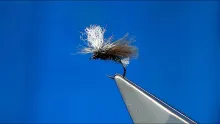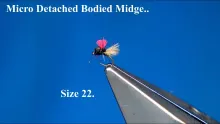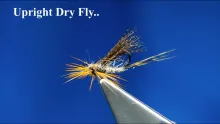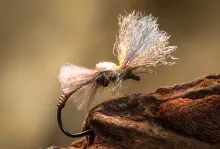A midge to Baetis crossover pattern with trident tails like seen on Baetis mayflies but tied with a downwing like a midge. The Midge-May Be has a body profile that suggests both insects--that is--- a segmented yet thin abdomen leading up to a leggy thorax. The fly also introduces a new wing material, CPE, that has a milky translucency like that seen on both naturals, yet is durable and tear-resistant.
Besides being a crossover pattern that has features of two insect families, the Midge-May Be is also designed to lay flat down in a depression it makes on the water surface as well as dimpling the surface film--like the phantom midge does in the video. The Baetis-like tails are thought cross over to look like the legs of a midge--midges who hold their front legs out in front of them like antennas. The tail/legs are thought important to the flies performance is that the tails and palmered fly body press into the film, depressing it and, at the same time dimpling it. Depression and dimpling of the film is thought to be an early visual clue to a trout that food may be floating towards them.
The Midge-May Be has been tested in streams and stillwaters throughout the Central Rockies and over the years has proven to be a widely useful attractor pattern.
______________________
Recipe
Hook:
I use a wide-gape dry-fly hook. Like a Firehole 419 light wire 2x gape hook or a Tiemco 100 sp-bl heavy wire 1.5x gape hook.
Hook Size:
Because the Midge-May Be is a midge and Baetis mayfly crossover need hook that spans the size of both those insect families. In the Central Rockies, river-based midges roughly span a size from 18 on down. Baetis span a size range of about 16-24. The crossover is about size 20 but can be a size 18 in the spring when the hatching insects tend to be larger. In the Fall, If needed, I fish it in a size 22 or 24. I don't tie this fly below size 24, because such small hooks often require playing the fish to exhaustion to land it.
Thread:
Semperfli Nanosilk 20D black. I keep the body as thin as possible because midges and Baetis both have a thin abdomen tapering slightly up to a rounded leggy Thorax. I tie in the thread and wind it using side by side wraps back the hook bend where I lash in the tails.
Tails:
I cut off three straight hairs from patch of moose body, even the tips up, and lash them at the hook bend projecting out at a length equal to the hook shank. I then pass the thread between hairs and pull to flair them out into a trident-like array. The tails are important to this flies performance. First of all, the tails act as outriggers to help the fly land upright on the surface film as well as by adding flotation help keep the fly floating parallel to the water surface. Second, the tails suggest midge legs or Baetis tails-- a key crossover feature because while midges do not have tails-- many species hold their front legs out front of them in an antenna-like way. In any case, trout don't seem to care/know which end is which on a tiny fly, nor can they count the number of tails/legs so its not unreasonable to expect they could be taken either as tails or legs. Finally, the tails/legs are thought important to the flies performance in that the tails press into the film, depressing and dimpling it making an early clue to a trout that food may be floating towards them. The palmered hackle on the fly body, tied in next, adds to the dimpling effect.
Body:
Palmered grizzly hackle trimmed flat-- reverse Mohawk style -- so fly is lays flat and low down in a depression its made in the film --as well as further dimpling the film -- again as shown in the video-- common for midges and mayflies lay low in water.
The stem of the palmered hackle makes for a segmented abdomen like seen on both midges and mayflies. Further, the palmered hackle trimmed flat sitting under the translucent wing used here makes for a diffusely-lit fuzzy bodied fly-- which by the response of the fish--is thought to be alluring to trout.
Wing:
For wing material, I use strips cut from a frosted CPE (chlorinated polyethylene) bag. You can buy 4 mil thick bags from Ebay for $9/100. CPE is a durable, tear-resistant lightweight plastic. CPE's frosting lets a diffuse light through unto palmered hackle-- lighting up the body like would happen on the naturals.
If needed, I use a strip cut from the bags welded seam to make a stiffer doubled wing. The strip is cut to about 2mm wide and 10-15 mm long for ease of handling.
Before lashing in the wing, I make several winds of thread just behind the hook eye to make a platform for the wing so that it is not wedged upward by the thickness of the palmered hackle. This platform allows the wing such to project more or less parallel to the the flat-cut hackle and hook shank. Trim the wing into a V-shape and a length just short of hook bend after lashing it in.
Double Whip finish.
Treat with you favorite floatant (I like Cortland's silicone spray) and fish it on a dead drift using a two-foot long 6x -7x tippet knotted to the end of a 9-12 ft leader tapered to 5x.
________________________
Gone Fishing, troutracker[at]yahoo[dot]com
- Log in to post comments







